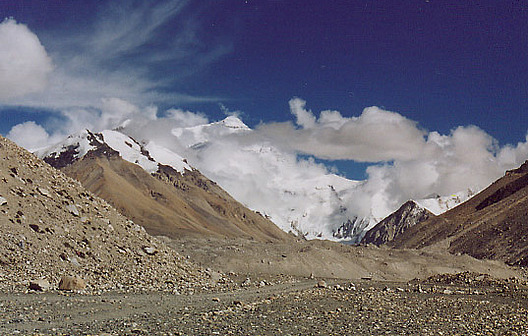Next morning we left for Dingri county where Mount Everest is located. The road conditions got much worse; the day was spent mostly in a long, bumpy, dusty ride. We had to breathe lots of dust and everything in the car was covered in it. Near Shekar town we had lunch in a roadside restaurant, where we bought a well-preserved fossil nautilus from a Tibetan boy there. Because Tibet was under the ocean only a few million years ago, this kind of fossils are commonly found here. At Gya'yu-La (mountain pass, 5060 m./16,600 ft.) we were treated with a magnificent view of snow-capped peaks to the south: Everest (8848 m./29,028 ft., the highest peak in the world, its Tibetan name is Chomolangma), Lotse (8516 m./27,939 ft., 4th highest), Cho Oyu (8153 m./26,748 ft., 8th), and Makalu (8463 m./27,765 ft., 5th). However, the clouds prevented us from seeing the tops of the peaks so we couldn't identify them. After Gya'yu-La we descended into broad glacier-sculpted valleys with numerous plots of green fields and a few villages. The huge smooth hills around the villages are extremely barren with not a single shred of vegetation.
We arrived at Mount Everest's north base camp along Rongpu creek in mid-afternoon. The elevation is 5100 m/16,700 ft., the weather was windy and moderately cold. The north face of Everest was mostly shrouded in clouds. Waiting for the clouds to clear, we went into a large tent-house sipping yak butter tea. The proprietors were Tibetan villagers from Tashi Dzong, just below Gya'yu-La. They're very friendly young people in the 20's, one of them told us he had been to 6500 m./21,300 ft. level on Everest. Some tourists sleep overnight in these tents in order to see sunrise on Everest, but we were afraid of altitude sickness, so we decided to head to lower ground after snapping a few good pictures of Everest. A short way back we stopped at Rongpu Monastery, the highest monastery in the world (4900 m./16,100 ft.) Some villagers on road-building jobs there greeted us and requested to have photos taken, so we obliged. They told us that there isn't a lot of work now because the rainy season is starting, which means no climbers and fewer tourists. We returned to Tashi Dzong village and stayed at a Tibetan family hotel with no running water, although the dinner was quite tasty. In the dining room we joined many people from the village plus a few tourists, about 30 people sat side by side around the room watching a taped TV series and exchanged a few words.

